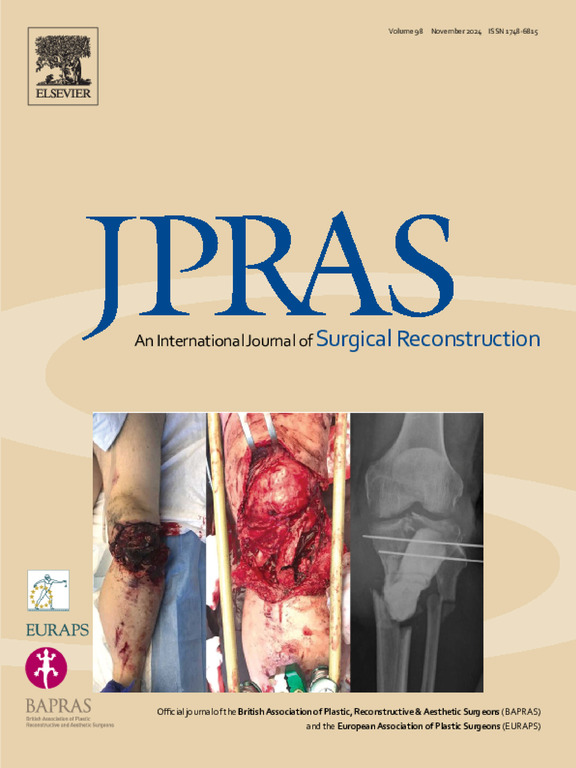显微外科的进展:人工智能应用的全面系统综述。
IF 2
3区 医学
Q2 SURGERY
Journal of Plastic Reconstructive and Aesthetic Surgery
Pub Date : 2025-02-01
DOI:10.1016/j.bjps.2024.11.023
引用次数: 0
摘要
机器学习(ML)是人工智能(AI)的一个分支,它使计算机能够在没有直接指令的情况下从数据中学习并识别模式。本文从人工智能应用的角度探讨了显微外科的前沿发展。通过分析广泛的研究,本文强调了人工智能在提高显微外科技术和决策过程中的变革性作用。使用Ovid MEDLINE、Ovid Embase、Web of Science和PubMed(2005-2023)进行系统的文献检索。从每项研究中收集了大量关于ML模型功能和组成的数据,以及更广泛的研究特征。使用非随机研究方法指数(未成年人)工具对人工智能研究的7个方法学领域的研究质量进行了评估。17项研究符合纳入标准。ML主要用于预后(35%)、术后评估(29%)和术中辅助/机器人手术(24%)。只有2项研究超过了人工智能研究的0阶段。14项研究包括训练组,但其中只有一项报告了验证集和训练集。ML模型的性能评估最常用的是准确性、特异性和敏感性。改编后的未成年人标准得分从10到14分不等,中位数为12分。通过整理所有可用的临床前和临床试验,本文综述了ML在各种显微外科应用中的疗效。尽管如此,这项技术的广泛采用仍然很少,目前受到个别研究方法缺陷和破坏性技术的结构性障碍的限制。然而,随着越来越多的证据支持其使用,显微外科医生应该接受实施ml合并技术,否则可能会有落后于其他专业的风险。本文章由计算机程序翻译,如有差异,请以英文原文为准。
Advancements in microsurgery: A comprehensive systematic review of artificial intelligence applications
Machine learning (ML) is a branch of artificial intelligence (AI) that enables computers to learn from data and discern patterns without direct instruction. This review explores cutting-edge developments in microsurgery through the lens of AI applications. By analyzing a wide range of studies, this paper highlights AI’s transformative role in enhancing microsurgical techniques and decision-making processes.
A systematic literature search was conducted using Ovid MEDLINE, Ovid Embase, Web of Science, and PubMed (2005–2023). Extensive data on ML model function and composition, as well as broader study characteristics, were collected from each study. Study quality was assessed across 7 methodological areas of AI research using an adapted methodological index of nonrandomized studies (MINORS) tool.
Seventeen studies met the inclusion criteria. ML was used primarily for prognosis (35%), postoperative assessment (29%), and intraoperative assistance/robotic surgery (24%). Only 2 studies were conducted beyond phase 0 of AI research. Fourteen studies included a training group, but only one of these reported both validation and training sets. ML model performance was assessed most frequently using accuracy, specificity, and sensitivity. Scores for the adapted MINORS criteria ranged from 10 to 14 out of 14, with a median of 12.
Through collation of all available preclinical and clinical trials, this review suggests the efficacy of ML for various microsurgical applications. Despite this, widespread adoption of this technology remains scarce, currently limited by methodological flaws of individual studies and structural barriers to disruptive technologies. However, with growing evidence supporting its use, microsurgeons should be receptive to implementing ML-incorporated technologies or may risk falling behind other specialties.
求助全文
通过发布文献求助,成功后即可免费获取论文全文。
去求助
来源期刊
CiteScore
3.10
自引率
11.10%
发文量
578
审稿时长
3.5 months
期刊介绍:
JPRAS An International Journal of Surgical Reconstruction is one of the world''s leading international journals, covering all the reconstructive and aesthetic aspects of plastic surgery.
The journal presents the latest surgical procedures with audit and outcome studies of new and established techniques in plastic surgery including: cleft lip and palate and other heads and neck surgery, hand surgery, lower limb trauma, burns, skin cancer, breast surgery and aesthetic surgery.

 求助内容:
求助内容: 应助结果提醒方式:
应助结果提醒方式:


